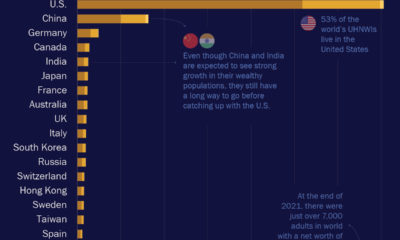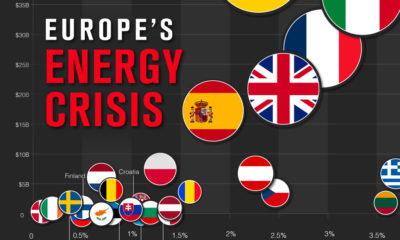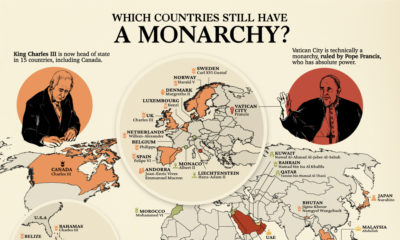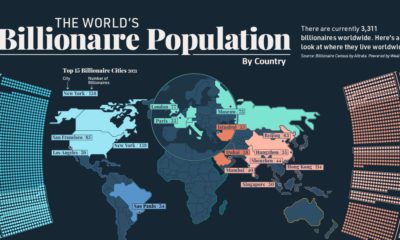 TweetShareShareRedditEmail
TweetShareShareRedditEmail
Written By Omri Wallach
Graphics & Design
- Sabrina Fortin
Published September 28, 2022
•
Updated September 28, 2022
•
The following content is sponsored by AFRY
Green Steel: Decarbonising with Hydrogen-Fueled Production
As the fight against climate change ramps up worldwide, the need for industries and economies to respond is immediate.
Of course, different sectors contribute different amounts of greenhouse gas (GHG) emissions, and face different paths to decarbonisation as a result. One massive player? Steel and iron manufacturing, where energy-related emissions account for roughly 6.1% of global emissions.
The following infographic by AFRY highlights the need for steel manufacturing to evolve and decarbonise, and how hydrogen can play a vital role in the “green” steel revolution.
The Modern Steel Production Landscape
Globally, crude steel production totalled 1,951 million tonnes (Mt) in 2021.
This production is spread all over the world, including India, Japan, and the U.S., with the vast majority (1,033 million tonnes) concentrated in China.
But despite being produced in many different places globally, only two main methods of steel production have been honed and utilised over time—electric arc furnace (EAF) and blast furnace basic oxygen furnace (BF-BOF) production.
Both methods traditionally use fossil fuels, and in 2019 contributed 3.6 Gt of carbon dioxide (CO2) emissions:
| Steel Production Method | Materials Utilised | CO2 Emissions (2019) |
|---|---|---|
| EAF | Scrap | 0.5 Gt |
| BF-BOF | Scrap, iron ore, coke | 3.1 Gt |
That’s why one of the main ways the steel industry can decarbonise is through the replacement of fossil fuels.
Hydrogen’s Role in Green Steel Production
Of course, one of the biggest challenges facing the industry is how to decarbonise and produce “green” steel in an extremely competitive market.
As a globally-traded good with fine cost margins, steel production has been associated with major geopolitical issues, including trade disputes and tariffs. But because of climate change, there is also a sudden and massive demand for carbon-friendly production.
And that’s where hydrogen plays a key role. Steel traditionally made in a blast furnace uses coke—a high-carbon fuel made by heating coal without air—as a fuel source to heat iron ore pellets and liquify the pure iron component. This expels a lot of emissions in order to get the iron hot enough to melt (1,200 °C) and be mixed with scrap and made into steel.
The green steel method instead uses hydrogen to reduce the iron pellets into sponge iron, metallic iron that can then be processed to form steel. This process is also done at high temperature but below the melting point of iron (800 – 1,200 °C), saving energy costs.
And by introducing non-fossil fuels to create iron pellets and renewable electricity to turn the sponge iron and scrap into steel, fossil fuels can be removed from the process, significantly reducing emissions as a result.
The Future of Green Steel Production
Given the massive global demand for steel, the need for hydrogen and renewable energy required for green steel production is just as significant.
According to AFRY and the International Renewable Energy Agency, meeting global steel production in 2021 using the green steel method would require 97.6 million tonnes of hydrogen.
And for a truly carbon-free transition to green steel, the energy industry will also need to focus on green hydrogen production using electrolysis. Unlike methods which burn natural gas to release hydrogen, electrolysis entails the splitting of water (H2O) into oxygen and hydrogen using renewable energy sources.
Full green steel production would therefore use green hydrogen, electrolysers running on renewables, and additional renewables for all parts of the supply chain:
| Steel Production Source | Annual Steel Production | Green Hydrogen Required | Electrolyser Capacity Required | Total Renewables Capacity Required |
|---|---|---|---|---|
| Base Reference | 1 Mt | 50 kT | 0.56 GW | 0.7 GW |
| U.S. | 85.8 Mt | 4.3 Mt | 48 GW | 60 GW |
| Europe | 103 Mt | 5.2 Mt | 58 GW | 72 GW |
| China | 1032.8 Mt | 51.6 Mt | 581 GW | 726 GW |
| Global | 1951 Mt | 97.6 Mt | 1,097 GW | 1,371 GW |
Currently, green hydrogen production costs are higher than traditional fossil fuel methods, and are dependent on the levelised costs of renewable energy sources. This means they vary by region, but also that they will reduce as production capacity and subsidies for renewables and green hydrogen increase.
And many major European steel manufacturers are already leading the way with pilot and large scale facilities for green steel production. Germany alone has at least seven projects in the works, including by ArcelorMittal and ThyssenKrupp, two of the world’s 10 largest steelmakers by revenue.
AFRY is a thought leadership firm that provides companies with advisory services and sustainable solutions, in their efforts to fight climate change and lead them towards a greater future.

Please enable JavaScript in your browser to complete this form.Subscribe to our free newsletter and get your mind blown on a daily basis: *Sign up
Related Topics: #steel #iron #green #Gas #green tech #renewable energy #renewables #manufacturing #iron ore #hydrogen #AFRY #steel production
Click for Comments
var disqus_shortname = "visualcapitalist.disqus.com";
var disqus_title = "Green Steel: Decarbonising with Hydrogen-Fueled Production";
var disqus_url = "https://www.visualcapitalist.com/sp/green-steel-decarbonising-with-hydrogen-fueled-production/";
var disqus_identifier = "visualcapitalist.disqus.com-152548";
You may also like
-

Markets20 hours ago
Visualized: The World’s Population at 8 Billion
Our population will soon reach a new milestone—8 billion. These visualizations show where all those people are distributed around the world
-

Datastream3 days ago
Top 20 Countries With the Most Ultra-Wealthy Individuals
Developing countries are creating wealth like never before, but the majority of the world’s ultra-wealthy people still live in the United States.
-

Energy5 days ago
What is the Cost of Europe’s Energy Crisis?
As European gas prices soar, countries are introducing policies to try and curb the energy crisis.
-

Markets1 week ago
The Biggest Tech Talent Hubs in the U.S. and Canada
6.5 million skilled tech workers currently work in the U.S. and Canada. Here we look at the largest tech hubs across the two countries
-

Politics2 weeks ago
Mapped: Which Countries Still Have a Monarchy?
Beyond the 15 nations under the British monarchy, 28 other countries still have a ruling monarch. Here’s a look at the world’s monarchies.
-

Money2 weeks ago
Mapped: The World’s Billionaire Population, by Country
Collectively, worldwide billionaire wealth is nearly $12 trillion. This map breaks down where these 3,311 billionaires live around the globe.
Subscribe
Please enable JavaScript in your browser to complete this form.Join the 300,000+ subscribers who receive our daily email *Sign Up
The post Green Steel: Decarbonising with Hydrogen-Fueled Production appeared first on Visual Capitalist.